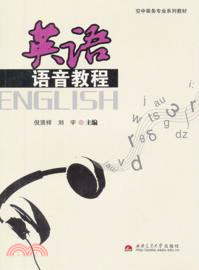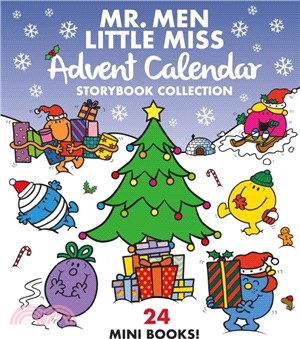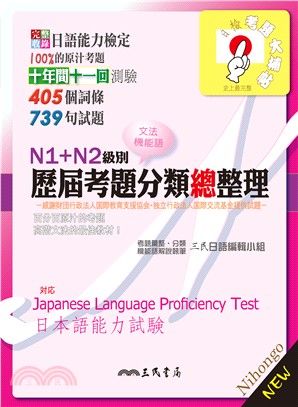商品簡介
作者簡介
名人/編輯推薦
目次
書摘/試閱
相關商品
商品簡介
《空中乘務專業系列教材:英語語音教程》是一本集語言理論與實踐于一體的教材,以通俗易懂的語音學理論知識為基礎,指導學生短期內解決英語發音的三個主要問題:音素、重音模式和語調。本教材共分四個部分,20個單元,各單元的設計著眼于實用,理論簡明易懂,語音練習材料豐富多彩,并配有英美專家的錄音,希望學習者反復聽練,以供學習、模仿之用。
作者簡介
倪賢祥,男,重慶梁平人,畢業于四川師范大學外國語學院英語語言文學專業。先后任教于中國民航飛行學院外國語學院和空中乘務學院,現為中國民航飛行學院空中乘務學院副院長,主管該學院教學與科研工作,長期從事應用語言學和民航專門用途英語的教學與研究。至今已主編空中乘務專業系列教材《乘務英語閱讀教材》《客艙播音》《客艙應急設施與程序》等,并在國內核心期刊上發表學術論文10余篇。
劉宇,男,四川成都人,畢業于四川大學外國語學院外國語言學及應用語言學專業。現為中國民航飛行學院空中乘務學院英語教師。主要研究方向為英語語言學及專門用途英語教學與研究。
劉宇,男,四川成都人,畢業于四川大學外國語學院外國語言學及應用語言學專業。現為中國民航飛行學院空中乘務學院英語教師。主要研究方向為英語語言學及專門用途英語教學與研究。
名人/編輯推薦
《空中乘務專業系列教材:英語語音教程》可作為空中乘務專業學生一年級英語語音課使用,也適用于其他專業旨在改善英語語音語調的英語學習者,亦可作為廣大英語教師的教學參考書。
目次
INTRODUCTION
Ⅰ. English Phonetics
Ⅱ. gnglish Spelling and Sounds
Ⅲ. Phonetic Transcription
Ⅳ. Model of English Pronunciation
Ⅴ. Articulators
CHAPTER ONE Individual Sounds of English
Unit 1 Classification of English Phonemes
1.1 Phonemes and Their Allophones
1.2 Classification of English Phonemes
Unit 2 Front Vowels
Unit 3 Central Vowels
Unit 4 Back Vowels
Unit 5 Diphthongs
5.1 Closing Diphthongs
5.2 Centring Diphthongs
Unit 6 Plosives
6.1 Bilabial Plosives
6.2 Alveolar Plosives
6.3 Velar Plosives
Unit 7 Fricatives
7.1 Labio-Dental Fricatives
7.2 Dental Fricatives
7.3 Alveolar Fricatives
7.4 Palate-Alveolar Fricatives
7.5 Glottal Fricative
Unit 8 Palate-Alveolar Affrieates
Unit 9 Nasals
9.1 Bilabial Nasal
9.2 Alveolar Nasal
9.3 Velar Nasal
Unit 10 Lateral
Unit 11 Aporoximants
11.1 Post-Alveolar Approximant
11.2 Palatal Approximant
11.3 Labial-Velar Approximant
Unit 12 Consonant Clusters
12.1 Consonant Clusters at the Beginning of Words
12.2 Consonant Clusters at the End of Words
CHAPTER TWO Sound Changes in Connected Speech
Unit 13 Strong and Weak Forms
Unit 14 Linking
Unit 15 Elision and Contraction
15.1 Elision
15.2 Contraction
Unit 16 Assimilation
16.1 Historical Assimilation
16.2 Contextual Assimilation
Chapter Three Stress Patterns
Unit 17 Word Stress
17.1 Concept of Stress
17.2 Degrees of Stress
17.3 Kinds of Stress
17.4 General Rules for Stress Placement
17.5 Word Stress
17.6 Compound Nouns
17.7 Word Class Pairs
17.8 Additional Practices
Unit 18 Sentence Stress
18.1 Stressed Words
18.2 Unstressed Words
CHAPTER FOUR Intronation
Unit 19 Intonation(1)
19.1 Falling and Rising Tones
19.2 Tails
19.3 Question Tags
19.4 Cleft Sentences
19.5 Questions(1)
19.6 Questions(2)
Unit 20 Intonation(2)
20.1 Repeat Questions
20.2 Comparisons and Contrasts
20.3 Requests and Reservation
20.4 Attitude Words and Phrases(1)
20.5 Attitude Words and Phrases(2)
Appendix Ⅰ Differences in Pronunciation between British English and American English
Appendix Ⅱ English Syllable Structure
Appendix Ⅲ Tense-Lax Vowel Alternations in Stressed Syllables of Base Forms and Derived Words
References
Ⅰ. English Phonetics
Ⅱ. gnglish Spelling and Sounds
Ⅲ. Phonetic Transcription
Ⅳ. Model of English Pronunciation
Ⅴ. Articulators
CHAPTER ONE Individual Sounds of English
Unit 1 Classification of English Phonemes
1.1 Phonemes and Their Allophones
1.2 Classification of English Phonemes
Unit 2 Front Vowels
Unit 3 Central Vowels
Unit 4 Back Vowels
Unit 5 Diphthongs
5.1 Closing Diphthongs
5.2 Centring Diphthongs
Unit 6 Plosives
6.1 Bilabial Plosives
6.2 Alveolar Plosives
6.3 Velar Plosives
Unit 7 Fricatives
7.1 Labio-Dental Fricatives
7.2 Dental Fricatives
7.3 Alveolar Fricatives
7.4 Palate-Alveolar Fricatives
7.5 Glottal Fricative
Unit 8 Palate-Alveolar Affrieates
Unit 9 Nasals
9.1 Bilabial Nasal
9.2 Alveolar Nasal
9.3 Velar Nasal
Unit 10 Lateral
Unit 11 Aporoximants
11.1 Post-Alveolar Approximant
11.2 Palatal Approximant
11.3 Labial-Velar Approximant
Unit 12 Consonant Clusters
12.1 Consonant Clusters at the Beginning of Words
12.2 Consonant Clusters at the End of Words
CHAPTER TWO Sound Changes in Connected Speech
Unit 13 Strong and Weak Forms
Unit 14 Linking
Unit 15 Elision and Contraction
15.1 Elision
15.2 Contraction
Unit 16 Assimilation
16.1 Historical Assimilation
16.2 Contextual Assimilation
Chapter Three Stress Patterns
Unit 17 Word Stress
17.1 Concept of Stress
17.2 Degrees of Stress
17.3 Kinds of Stress
17.4 General Rules for Stress Placement
17.5 Word Stress
17.6 Compound Nouns
17.7 Word Class Pairs
17.8 Additional Practices
Unit 18 Sentence Stress
18.1 Stressed Words
18.2 Unstressed Words
CHAPTER FOUR Intronation
Unit 19 Intonation(1)
19.1 Falling and Rising Tones
19.2 Tails
19.3 Question Tags
19.4 Cleft Sentences
19.5 Questions(1)
19.6 Questions(2)
Unit 20 Intonation(2)
20.1 Repeat Questions
20.2 Comparisons and Contrasts
20.3 Requests and Reservation
20.4 Attitude Words and Phrases(1)
20.5 Attitude Words and Phrases(2)
Appendix Ⅰ Differences in Pronunciation between British English and American English
Appendix Ⅱ English Syllable Structure
Appendix Ⅲ Tense-Lax Vowel Alternations in Stressed Syllables of Base Forms and Derived Words
References
書摘/試閱
When we ask a question, we might be trying to find out information that wedont already know. Alternatively, we might ask a question in order to make sure that information we think we know is, in fact, correct.
Finding out questions usually end with a falling tone:
What part of Spain were you in ? How much are they ?
Note: Because wh- questions are often used to find out information, they often,although not always, end with a falling tone.
Making sure questions usually end with a rising or fall-rising tone:
Was Brian there ? or: Was Brian there ?
Doesnt she work with you ? or: Doesnt she work with you ?
Note: Because yes-no questions are often used to make sure, they often, althoughnot always, end with a rising or fall-rising tone.
However, wh- questions can have a rising or fall-rising tone when they aremaking sure, and yes-no question can have a falling tone when they are finding out:
Whens your birthday ? (a rising tone shows that Im checking the date; itmight be polite to suggest that I do know but have temporarily forgotten.)
Have you seen her recently ? (I dont know whether you have or not.)
In making sure questions we can usually use a fall-rising tone or a rising tonewith little difference in meaning. However, a fall-rising tone often sounds more politethan a rising tone. In particular, a fall-rising tone is often preferred in questions askedfor social reasons; that is, mainly to be polite and friendly rather than to checkinformation.
主題書展
更多
主題書展
更多書展今日66折
您曾經瀏覽過的商品
購物須知
大陸出版品因裝訂品質及貨運條件與台灣出版品落差甚大,除封面破損、內頁脫落等較嚴重的狀態,其餘商品將正常出貨。
特別提醒:部分書籍附贈之內容(如音頻mp3或影片dvd等)已無實體光碟提供,需以QR CODE 連結至當地網站註冊“並通過驗證程序”,方可下載使用。
無現貨庫存之簡體書,將向海外調貨:
海外有庫存之書籍,等候約45個工作天;
海外無庫存之書籍,平均作業時間約60個工作天,然不保證確定可調到貨,尚請見諒。
為了保護您的權益,「三民網路書店」提供會員七日商品鑑賞期(收到商品為起始日)。
若要辦理退貨,請在商品鑑賞期內寄回,且商品必須是全新狀態與完整包裝(商品、附件、發票、隨貨贈品等)否則恕不接受退貨。
優惠價:87
125
海外經銷商無庫存,到貨日平均30天至45天
























